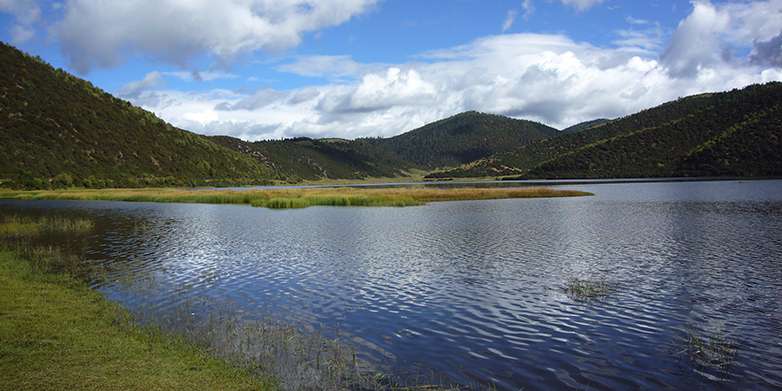April 23, 2015 report
Research trio suggest low-relief mountain surfaces due to river network disruption

(Phys.org)—A trio of researchers, two with the Swiss Federal Institute of Technology and the other with Ben-Gurion University of the Negev, claim to have found evidence that suggests low-relief mountain surfaces are due to river disruption, not tectonic uplift. In their paper published in the journal Nature, Rong Yang, Sean Willett and Liran Goren describe how they showed that a portion of the Tibetan Plateau likely did not come about due to tectonic uplift and instead suggest an alternative explanation. Jérôme Lavé with Centre de Recherches Pétrographiques et Géochimiques in Rome offers a News & Views piece on the work done by the trio in the same journal issue.
For many years geologists have puzzled over flat plains that exist at high altitude in mountain ranges. Common sense suggests mountains should be jagged, especially those that formed due to pressure between the Earth's plates. Over the years, a grudging consensus has been reached—the flat plains must have got to where they are by simple uplifting—whole sections of flat earth were pushed up intact, along with the other parts of the mountain as plates collided. This idea has not been wholly embraced of course, because in many ways it seems to defy logic. In this new effort, the three researchers started out as skeptics, in looking at a part of the Tibetan Plateau known as the "Three Rivers Region"—where the Yangtze, Mekong and Salween rivers incise the plain, they could not find a way to simulate the area being uplifted, so they began to look for another explanation. To do that, they input geologic data that describes the area into a model, one that took into account the unexpectedly shallow tributaries in some parts of the Plateau and also others that were steeper—evidence, they suggest, of recent drainage.
The model the trio came up with shows that the Plateau came about due to a reorganization of the river network after uplift, because parts of them became isolated. Subsequent erosion of the resultant landscape led to the flat terrain as it can be seen today. Lavé allows that the model does show what the trio suggest, but also notes that it does not seem to work as well when shifting the focus farther north in the region. He suggests future modeling should take into consideration the new findings, however, as it appears the research trio have come up with a new way of thinking about low-relief mountain surface formation.
More information: In situ low-relief landscape formation as a result of river network disruption, Nature 520, 526–529 (23 April 2015) DOI: 10.1038/nature14354
Abstract
Landscapes on Earth retain a record of the tectonic, environmental and climatic history under which they formed. Landscapes tend towards an equilibrium in which rivers attain a stable grade that balances the tectonic production of elevation and with hillslopes that attain a gradient steep enough to transport material to river channels. Equilibrium low-relief surfaces are typically found at low elevations, graded to sea level. However, there are many examples of high-elevation, low-relief surfaces, often referred to as relict landscapes, or as elevated peneplains. These do not grade to sea level and are typically interpreted as uplifted old landscapes, preserving former, more moderate tectonic conditions. Here we test this model of landscape evolution through digital topographic analysis of a set of purportedly relict landscapes on the southeastern margin of the Tibetan Plateau, one of the most geographically complex, climatically varied and biologically diverse regions of the world. We find that, in contrast to theory, the purported surfaces are not consistent with progressive establishment of a new, steeper, river grade, and therefore they cannot necessarily be interpreted as a remnant of an old, low relief surface. We propose an alternative model, supported by numerical experiments, in which tectonic deformation has disrupted the regional river network, leaving remnants of it isolated and starved of drainage area and thus unable to balance tectonic uplift. The implication is that the state of low relief with low erosion rate is developing in situ, rather than preserving past erosional conditions.
Journal information: Nature
© 2015 Phys.org


















